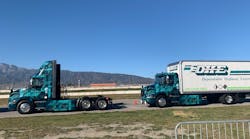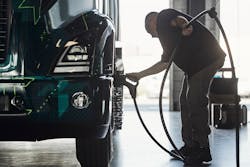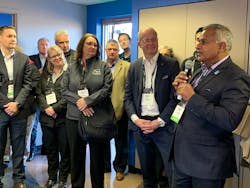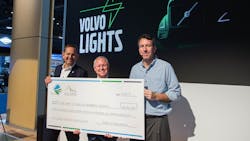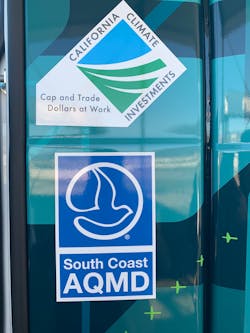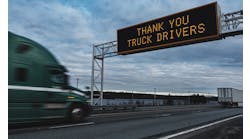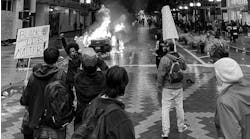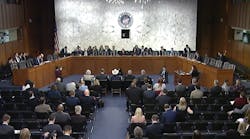After a full day of test drives, interactive demonstrations, speeches and panel discussions at the Volvo LIGHTS Innovation Showcase, Peter Voorhoeve, president of Volvo Trucks North America, said the most important takeaway is pretty simple.
"It’s real. It’s working,” Voorhoeve told Fleet Owner in an interview alongside the five battery electric VNR regional haul models that highlighted the Feb. 11 gathering. “They were not on a stage — they were on a track. You got to drive a vehicle yourself. It is happening.”
The several hundred dealers, fleet customers and government officials invited to TEC Equipment’s dealership and the Auto Club Speedway in Fontana, CA, also had the chance to get behind the wheel of the trucks that will now be put into service in Southern California by Dependable Highway Express and NFI.
The showcase was about much more than just these trucks — the focus was about “the million elements around it,” Voorhoeve said. He was referring to the charging infrastructure, demand on the local power grids and other operational changes that come with the transition.
The LIGHTS (Low Impact Green Heavy Transport Solution) program brings together Volvo, the California Air Resources Board (CARB), the South Coast Air Quality Management District (AQMD) and 14 industry partners aimed at accelerating the deployment of zero-emission electric trucks.
“We need government help. It won’t happen without it - it is not economically viable yet,” Voorhoeve acknowledged.
Before the end of the year, about 18 more VNRs will be put into service, and Volvo will begin limited production at its New River Valley manufacturing facility in Virginia.
Can California and trucking be friends?
The wind was strong in Fontana during the event, which Naveen Berry, assistant deputy executive officer of the South Coast AQMD, said aided in the clear, sunny sky during the test drives. It provided a picturesque scene at the racetrack, but Berry pointed out the conditions are often far different, particularly during the summer months.
Voorhoeve recalled going for a jog last May in nearby Long Beach during the Advanced Clean Transportation (ACT) Expo. Seeing the smoggy sky that morning reminded him “that something needs to be done” about the air quality in the region.
It was at ACT Expo that CARB presented a check for $44.8 million to the South Coast AQMD to help finance Volvo LIGHTS projects.
For Voorhoeve, that's a perfect example of the positive partnership between the industry and the state whose strict emission and labor regulations often draw the ire of truckers.
In response to a question about that tenuous relationship, he replied, "I don’t think California and trucking are necessarily ‘bad’ friends.”
He continued: "The California government, of course, is rather aggressive on air quality, and so should they be. And they are going at a different pace than the rest of the country." Many European cities are implementing emission regulations that are "almost as strict as California, so I’m not sure it is bad for trucking.”
CARB is "strict and they take the climate very seriously,” but the agency’s millions of dollars in financial support helped create the battery electric VNR, which will offer drivers less noise and a more comfortable work environment.
“How is this not good for a truck driver?” he asked.
In a show of the industry-government collaboration, numerous CARB officials were on hand. Annette Hebert, CARB’s assistant executive officer in Southern California, said the event was useful to illustrate how the funding is being used and how the partners are working together.
It also helps refine ideas on how to tailor future funding to further accelerate real-world adoption of these trucks.
That funding extends to job training courses at several local colleges. Two of the professors already using grant money to expand cutting-edge programs on this technology were in attendance at the event.
Still more questions than answers
While the Volvo LIGHTS showcase was a reason for celebration, Voorhoeve repeatedly stressed the work is just beginning.
Currently, the range of these initial VNRs is about 75 to 175 miles. Those figures should only increase as battery technology improves. When it comes time for the official launch, Volvo will “come out the specs you need for normal transport - in the neighborhood of 80,000 lbs. and you will see the ranges at that time,” Voorhoeve told fleet customers in attendance.
"This is going to be a full-blown mature green heavy transport solution,” he declared in his closing remarks.
Beyond the clear need for government incentives to lower the price tag, Voorhoeve said fleets need to look at the “total cost of ownership” (TCO) to accurately compare electric and diesel trucks.
Manufacturers often use variations of that phrase in marketing brochures. In this case, however, TCO incorporates new variables into an old equation.
With fewer moving parts, the expectation is that maintenance expenses will go down for fleet running electric trucks. Less maintenance does not mean “no maintenance,” Voorhoeve warned. The trucks still have fuel filters, brake pads, tires, lights and other parts that still will wear down over time.
Electric trucks will create “different maintenance” needs and dealers will offer other related services that come with the charging systems and routing optimization tools critical to successful adoption.
Understanding the maintenance picture, the overall “fuel” efficiency and residual value of the vehicles will yield a clearer picture on whether electric trucks will fit into a fleet’s operations. It’s exactly the information the Volvo LIGHTS partners are working together to better define.
Voorhoeve believes it is when, not if, the pendulum will swing in the favor of electrics in many of these business cases. With all the interest and cooperation at events like this one, it’s hard to argue with that opinion.
